Exfoliation is key for acne-prone skin, but it should only happen once or twice weekly1. This process removes dead skin cells and excess oils that can cause breakouts. Let’s explore how to safely exfoliate and treat acne without irritating your skin.
Finding the right exfoliator for your skin may take some trial and error1. Be gentle during this process. Choose a treatment that matches your specific skin type for the best results.
Back acne, or “bacne,” occurs when pores on the back, chest, and shoulders get clogged1. Adding exfoliation to your body care routine can help tackle this issue. Remember, skin is more sensitive after exfoliating.
Always moisturize and apply sunscreen after exfoliating to protect your skin1. Don’t exfoliate for at least a few days to a week after treatments like facials or waxing1. This allows your skin time to heal.
Key Takeaways
- Exfoliate acne-prone skin only once or twice a week to avoid irritation
- Choose an exfoliator suitable for your skin type and be gentle during application
- Back acne can be treated by incorporating exfoliation into your body care routine
- Moisturize and apply sunscreen after exfoliation to protect sensitive skin
- Avoid exfoliating for a few days to a week after facial treatments or waxing sessions
Stay tuned for top reviews on beauty supplies. We cover everything from acrylic nails to hair growth serums. Our expert picks include the best skincare routines, vegan products, and anti-aging creams. We’ve got you covered for all your beauty needs.
The Benefits of Exfoliating for Acne-Prone Skin
Exfoliating is a game-changer for acne-prone skin. It helps reduce breakouts and prevents clogged pores. By removing dead skin cells, we can stop comedones from forming2.
There are two main types of exfoliants: physical and chemical. Physical exfoliants are gritty substances in face wash or cleansing tools. They slough off dead skin cells when rubbed in circular motions3.
However, physical exfoliants may irritate inflamed skin. This can worsen redness and existing breakouts2.
Unclogging Pores and Removing Dead Skin Cells
Chemical exfoliants dissolve dead cells without abrasive agents2. These include alpha hydroxy acids (AHA) and beta hydroxy acids (BHA). They break down the “glue” holding skin cells together3.
Over-the-counter chemical exfoliants, like glycolic peels, can be gentle enough for daily use. Stronger treatments, such as salicylic acid peels, are available at day spas2.
Improving Skin Texture and Reducing Acne Scars
Regular exfoliating with the right products improves skin texture. It also reduces the appearance of acne scars over time. Oily skin benefits from exfoliators with BHAs like benzoyl peroxide or salicylic acid3.
Be gentle and avoid over-exfoliating. This can cause redness, dryness, irritation, and more breakouts. If this happens, reevaluate your exfoliant type and frequency3.
Most chemical exfoliants can dry the skin. Use an oil-free moisturizer to prevent dryness, peeling, and irritation2. If you’re using acne medications, consult a dermatologist before starting any exfoliation treatment2.
Check back often for the best reviews on beauty supplies. We cover foundations, makeup brushes, moisturizers, vegan products, acrylic nails, and more. Find top picks for hair care, skincare, and anti-aging products too.
Types of Exfoliants Suitable for Acne-Prone Skin
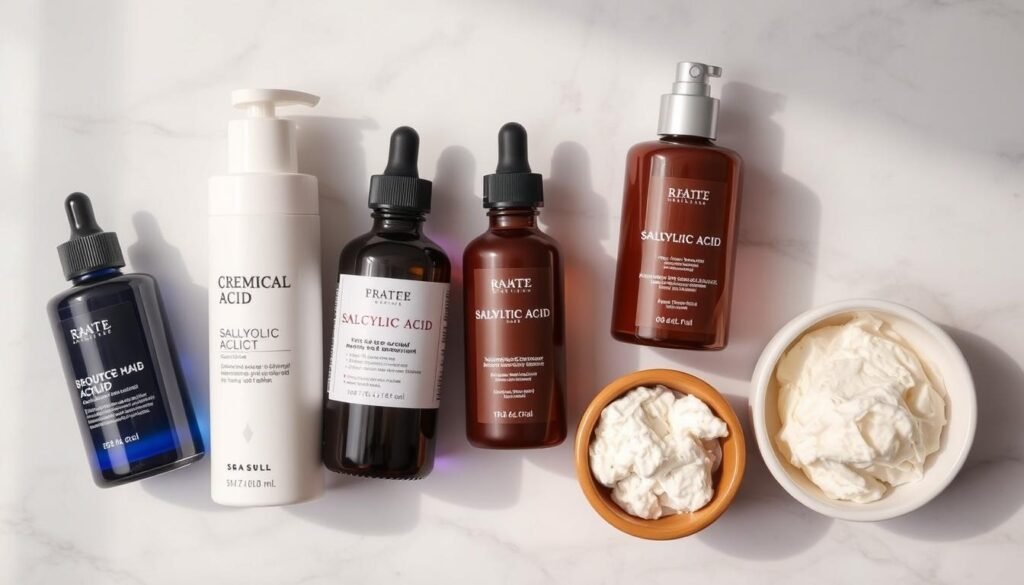
Choosing the right exfoliant is vital for acne-prone skin. Exfoliants remove debris that can clog pores and cause acne. There are two main types: chemical and physical exfoliants.
Chemical Exfoliants: AHAs, BHAs, and PHAs
Chemical exfoliants are often recommended for acne treatment. They can penetrate pores to remove oil and debris. AHAs improve skin texture and pigmentation by breaking up dead skin cells.
BHAs, like salicylic acid, can reach deep into pores. They unclog them and fight acne-causing bacteria. PHAs are gentler alternatives to AHAs, suitable for sensitive skin.
When using chemical exfoliants, consider the timing of your acne treatment. Over-exfoliating can dry out skin and cause redness. Start slow and build up gradually4.
Gentle Physical Exfoliants for Sensitive Skin
Fine-grained scrubs can work for sensitive skin. Avoid excessive rubbing to prevent irritation. Scrubs with abrasives may worsen cystic acne and bumpy types of acne4.
Beaded exfoliants are too harsh for acne-prone or sensitive skin. Instead, choose gentle, non-abrasive options. La Roche-Posay’s Effaclar Astringent Lotion contains micro-exfoliants suitable for acne-prone skin5.
Retinol, found in La Roche Posay’s Redermic range, promotes new cell production. It stimulates cellular turnover from deeper layers, making it excellent for acne-prone skin5.
“Choosing the right type of exfoliant for your acne-prone skin is key to both treating your acne and maintaining the health of your skin. I always recommend starting gently and gradually increasing frequency and strength as your skin adapts.”
The stages of acne influence the choice of exfoliants. Select the right exfoliant for your skin type and acne severity. This can effectively unclog pores, refine skin texture, and solve blemish problems5.
Check back often for the best reviews on beauty supplies. We cover vegan beauty products, cruelty-free makeup, anti-aging cream, and more.
How to Safely Exfoliate Acne-Prone Skin
Exfoliating acne-prone skin requires careful consideration. The right exfoliant and proper techniques can lead to clearer, smoother skin. Let’s explore how to safely add exfoliation to your acne treatment routine.
Choosing the Right Exfoliant for Your Skin Type
Selecting an exfoliant that suits your skin type is crucial. For sensitive skin, try lactic acid, a gentle AHA. Oily or resilient skin may benefit from salicylic acid, a BHA that penetrates pores.
Glycolic or lactic acid products can help keep pores clear. Glycolic acid penetrates deeper, while lactic acid is gentler for sensitive skin67.
Frequency and Technique for Optimal Results
Use chemical exfoliants no more than twice a week to avoid worsening acne. Apply the product using gentle, circular motions. Don’t scrub too hard, as this can irritate your skin.
Avoiding Over-Exfoliation and Irritation
Monitor your skin’s reaction to new products. Introduce one new item at a time to track its impact. Reduce frequency or switch products if you notice increased redness or irritation7.
Always moisturize after exfoliating to keep your skin hydrated. Choose non-comedogenic formulas with ingredients like hyaluronic acid for added hydration and protection6.
Remember, everyone’s skin is unique. Be patient as you incorporate exfoliation into your routine. Check back for reviews on acne treatments, exfoliators, moisturizers, sunscreens, and other skincare products.
Can I Use Acne Treatment After Exfoliating?
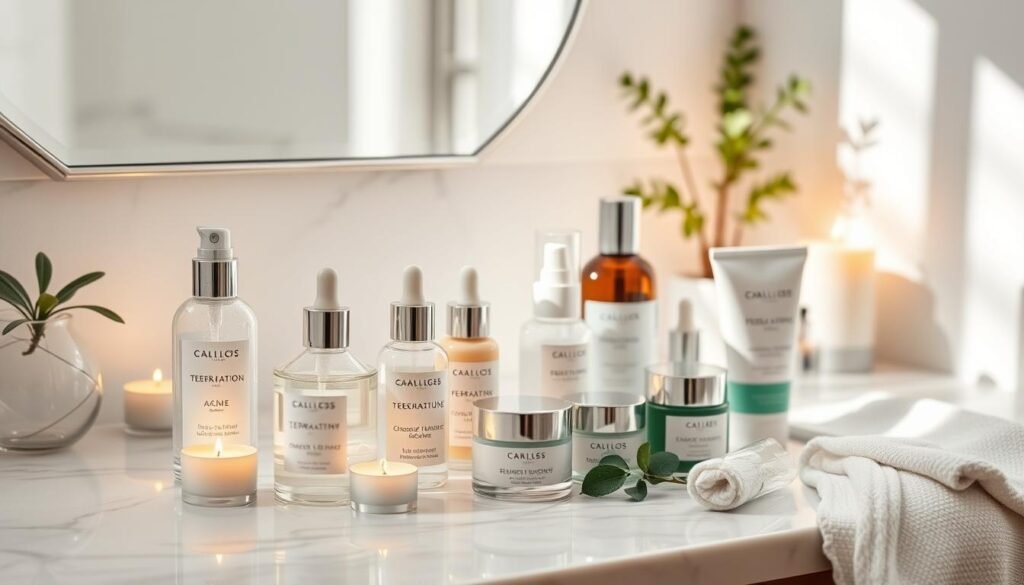
Exfoliation is vital for acne-prone skin. It unclogs pores and removes dead skin cells. However, using acne treatments after exfoliating requires careful consideration.
Timing Your Acne Treatment Application
After a strong exfoliant, wait a few days before using acne medications. This allows your skin to heal and reduces irritation risk.
For regular exfoliation, apply acne treatments afterward. This helps active ingredients absorb better into cleared pores. Acne spot treatments usually cost between $14 and $25 USD8.
Combining Exfoliation and Acne Medication Safely
Watch for signs of irritation when using exfoliants and acne treatments together. If your skin feels sensitive, reduce exfoliation frequency or use gentler products.
Lactic acid, a milder AHA, works well for sensitive skin9. It’s gentler and less likely to cause irritation.
Use a quality moisturizer and sunscreen after exfoliating. Hyaluronic acid moisturizers, priced $15-$25 USD, keep skin hydrated8.
Hyaluronic acid attracts 1000 times its weight in water9. This provides long-lasting hydration for your skin.
Finish with a daily moisturizer containing SPF 15. These typically cost around $30 USD8.
By carefully selecting my post-exfoliation acne products and listening to my skin’s needs, I’ve found a balance that keeps my complexion clear and healthy.
Everyone’s skin is unique. What works for one person may not work for another. Consult a dermatologist for a personalized skincare plan.
Visit us for reviews on beauty supplies. We cover skincare, makeup, hair care, and more. Find the best products for your needs.
Post-Exfoliation Skincare for Acne-Prone Skin
After exfoliating acne-prone skin, a supportive skincare routine is crucial. It helps the healing process and prevents irritation. Exfoliating acids can make skin more sensitive to UV light. A balanced post-exfoliation routine is key for clear, healthy skin.
Moisturizing to Prevent Dryness and Irritation
Moisturizing is vital after exfoliation. Your skin may feel dry or sensitive. Use a light, non-comedogenic moisturizer to hydrate without clogging pores.
Look for ingredients like hyaluronic acid. It’s found in products like HA-Revive Hyaluronic Drops and Oil Free Emulsion10.
Choose a moisturizer based on your skin type. Oily skin? Try a gel or water-based product. Dry or sensitive skin? Go for a creamy formula with soothing ingredients.
Sun Protection: The Importance of SPF
Sun protection is crucial after exfoliation. Your skin becomes more vulnerable to sun damage. Use a broad-spectrum SPF daily to shield against harmful UV rays.
Pick a light, non-greasy sunscreen with SPF 30 or higher. Vitamin C also protects skin. It’s in C-Shield Anti-Pollution Drops and Hydra-Bright Vitamin C Drops10.
Apply sunscreen last in your routine. This ensures protection throughout the day, even indoors.
Remember, consistency is key when it comes to maintaining a healthy skin care regimen with exfoliation and acne treatment. Stick to your routine, and you’ll soon see the benefits of a well-balanced approach to managing acne-prone skin.
Keep an eye out for updates on effective skincare products. These include hyaluronic serums, vegan makeup, and teeth whitening treatments. We’ll also cover anti-wrinkle creams, collagen creams, and hair removal products.
Acne Treatment and Exfoliation During Different Seasons
Seasons affect my acne skin care routine. Summer brings more breakouts due to sun, sweat, and irritants11. I exfoliate 2-3 times weekly using AHAs, BHAs, and fruit enzymes12.
I choose exfoliants based on my skin type. Oily skin benefits from physical scrubs, while dry skin prefers chemical exfoliants13.
Winter’s cold air and low humidity dry out my skin11. I reduce exfoliation to 1-2 times weekly to prevent irritation12. Gentle chemical exfoliants work well for thin, sensitive skin types1213.
After exfoliating, I apply hydrating serums and moisturizers. This prevents dryness and irritation12. Daily sunscreen is crucial as exfoliated skin is more sun-sensitive13.
Adapting my acne skin care routine and exfoliation habits to the changing seasons helps keep my skin healthy, balanced, and glowing all year round.
| Season | Acne Concerns | Exfoliation Tips |
|---|---|---|
| Summer | Increased breakouts, oily skin | Maintain 2-3 times/week, use blends of AHAs, BHAs, and enzymes |
| Winter | Dryness, irritation | Reduce to 1-2 times/week, use gentle chemical exfoliants |
Tailoring my acne-prone skin exfoliation routine helps manage acne year-round. Consistency is key for healthy, radiant skin. Explore our reviews on beauty supplies like acrylic nails, nail polish remover, and hair color kits.
We also cover hair growth serums, moisturizers for dry skin, and vegan beauty products. Find info on cruelty-free makeup, anti-aging creams, and foundations for oily skin. Check out our best makeup brushes and beauty blender recommendations too.
Conclusion
Exfoliating can transform your acne skin care routine. It unclogs pores, removes dead skin cells, and improves skin texture. This helps manage acne-prone skin effectively14. Choose the right exfoliant for your skin type. Be careful about frequency and technique to avoid irritation15.
Timing matters when combining exfoliation and acne medication. Apply acne treatment after exfoliating for best results. Use safe treatments and maintain a balanced skincare routine. Include proper moisturization and sun protection1516.
Listen to your skin and adjust your routine as needed. Environmental factors can affect your skin’s needs during different seasons. Consult a dermatologist for personalized advice if you have concerns.
With the right approach and products, you can manage acne successfully. Achieve the clear, radiant skin you deserve. Check back often for reviews on various beauty supplies. We cover everything from acrylic nails to anti-aging creams.
FAQ
What are the benefits of exfoliating acne-prone skin?
What types of exfoliants are suitable for acne-prone skin?
How often should I exfoliate my acne-prone skin?
Can I use acne treatments after exfoliating?
What should I do after exfoliating to take care of my acne-prone skin?
Source Links
- Do’s and Don’t’s of Exfoliation – Premier Dermatology – https://premierdermde.com/dos-and-donts-of-exfoliation/
- Exfoliation Tips to Help Acne-Prone Skin – https://www.verywellhealth.com/exfoliation-basics-15626
- Does Exfoliating Help with Acne? – https://www.proactiv.com/blog/treating-face-acne/does-exfoliating-help-with-acne
- You asked, we answered: How to exfoliate acne-prone skin | Murad – https://wellconnected.murad.com/how-to-exfoliate-acne-prone-skin/
- How to properly exfoliate acne-prone skin | La Roche-Posay – https://www.laroche-posay.sg/article/how-to-properly-exfoliate-acne-prone-skin
- A Complete Guide To Chemical Exfoliation For Acne – https://www.gloskinbeauty.com/blog/a-complete-guide-to-chemical-exfoliation-for-acne?srsltid=AfmBOorrUROcUopHY1HvWPOaUou7dl0xCWhydfXk3SktXCwwu27qxMPz
- How To Treat Acne: 4 Things To Always Do and 3 To Avoid – https://www.shanidarden.com/blogs/shanis-skin-care-tips/how-to-deal-with-acne?srsltid=AfmBOorkQ4lN5MAydctmFUNZSf6GefZpvHDJZix59z5MiDQI22PrhqwX
- The Right Way to Layer Your Skincare – https://slmdskincare.com/blogs/learn/the-right-way-to-layer-your-skincare?srsltid=AfmBOoqtoRqb8GfZVKz1WcTyO_vqaGpwZ9o7KGrXLOYraZxTXTWwcPet
- A Complete Guide To Chemical Exfoliation For Acne – https://www.gloskinbeauty.com/blog/a-complete-guide-to-chemical-exfoliation-for-acne?srsltid=AfmBOoqaX5rQBDLivFtYW8Qry2oPDgG58qsNmrHOSJcHHkOk1DZamWb1
- A Complete Guide To Chemical Exfoliation For Acne – https://www.gloskinbeauty.com/blog/a-complete-guide-to-chemical-exfoliation-for-acne?srsltid=AfmBOor421aRH10Tt14iALXqxwWXm5q2itEtb1q-cCr3QN_x6Nhxv133
- How to Treat Acne During the Winter | Short Hills Dermatology – https://shorthillsderm.com/blog/acne/how-to-treat-acne-during-the-winter/
- Flawless Fall: Mastering Seasonal Exfoliation – https://www.cosmedicaltechnologies.com/blogs/blog/flawless-fall-mastering-seasonal-exfoliation
- Summer Exfoliation 101: The Dos, Don’ts & Benefits of Exfoliating – perricone-uscom – https://www.perriconemd.com/blog/summer-exfoliation-101-the-dos-donts-benefits-of-exfoliating/?srsltid=AfmBOorazPPS6NZ4bypAGMbXVUVldevdSCKa7LJMg3rM4Dzrsa2QkdD4
- Does Exfoliating Help With Acne? What You Need to Know – https://lemonandbeaker.com/en-de/blogs/news/does-exfoliating-help-with-acne-what-you-need-to-know
- Can Exfoliating Cause Acne? (Everything You Need to Know) – https://www.exposedskincare.com/blogs/blog/can-exfoliating-cause-acne
- A Comprehensive Bibliographic Review Concerning the Efficacy of Organic Acids for Chemical Peels Treating Acne Vulgaris – https://www.ncbi.nlm.nih.gov/pmc/articles/PMC10608815/


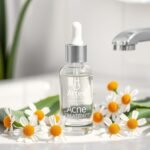
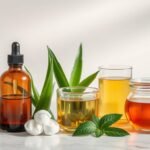

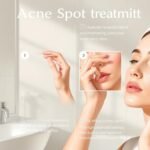
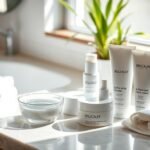
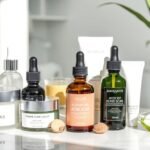
Interesting read, but ever considered that exfoliating might be overrated? Could we be damaging our skin more than helping it? Just food for thought.
Interesting read, but what if exfoliating is overrated? Arent we just irritating our skin more? Just food for thought, pals.
Interesting read but arent we just feeding a skincare industry that profits from our insecurities? Isnt natural skin okay anymore?
Interesting read, but ever considered that acne might be our skins natural defense against pollution? Just a wild thought.
Wild thought indeed, but perhaps oversimplified. Acnes roots extend beyond mere pollution defense.
Interesting read, but isnt it possible that excessive exfoliating might actually exacerbate acne? Lets not ignore skin sensitivity folks!
Interesting read, but arent we overlooking the potential damage of over-exfoliation? Could it lead to more acne instead of less? Just food for thought.
Interesting read, but arent we just aggravating the acne further by exfoliating? Maybe were just overcomplicating a simple cleanse, tone, and moisturize routine?
While I agree exfoliation helps, isnt aggressive scrubbing actually bad for acne-prone skin? Could it possibly worsen inflammation? Just a thought.
Interesting read, but arent we glorifying exfoliating too much? What about the risk of over-exfoliation causing more harm than good? Lets balance the narrative.
Interesting read, but arent we overselling exfoliation here? What about the risk of skin damage and inflammation? Any thoughts?
Not convinced here, guys. Ever thought that excessive exfoliation might just worsen acne by irritating the skin? Lets discuss this.